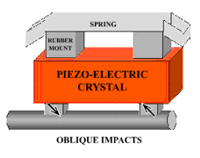
| Home | ||
| Tactile Displays | ||
| ER Fluids | ||
| Actuators | ||
| News | ||
| Contact Us | ||
|
A piezo-electric actuator is an electromechanical device
that undergoes a dimensional change when a voltage is applied. The
conversion of electrical energy into mechanical motion takes place
without any significant magnetic field. By employing piezo-electric
effects to generate various mechanical wave distributions, motion
is achieved by placing the object to be driven in direct contact with
the piezo-electric element. In comparison to the performance of conventional electromagnetic motors, which are limited by the relatively high rotor inertia, using this technology allows both high resolution positioning and high speed response. |
Piezo-electric actuators are typically very compact, because when compared to other technologies fewer components are used in a complete system. The actuator itself can be very small, and devices have been made whose active element varies in size from 1cm to 4cm.
Smart actuators demonstrate very low electrical noise. Conventional electromagnetic motors use high magnetic fields. These fields are either oscillating or are switched by a moving commutator. Rapidly varying magnetic fields, and the sparks produced at the commutator (if the motor has one) are severe sources of electrical noise. Piezo-electric devices respond to electric fields, and operate at much lower current than electromagnetic devices. Screening them is therefore easier and more effective.This makes them ideal for use in sensitive instrumentation and low-noise environments such as MRI scanners
The Key Features of Piezo Actuators are:
- High torque at low speed (at moderate efficiency) .
- Direct drive without gears.
- Excellent dynamics - high torque and low inertia.
- High resolution and fine positioning (steps of less than 1 micron).
- Stable operation maintained at low speed.
- Simple mechanical structure.
- Easy to miniaturise and mass produce.
- Flexibility in shape and configuration.
- Quiet operation (ultrasonic frequency range).
- No magnetic interference (suitable for medical MRI applications).
- Safe operation at power cut off as the system will maintain its position due to friction forces.
Next Page: Actuator Examples >>
